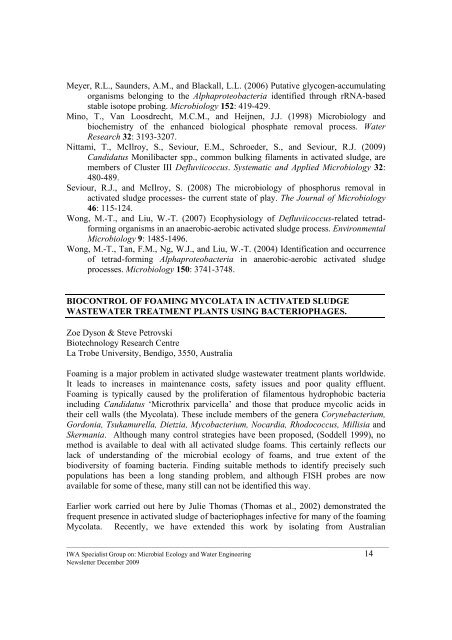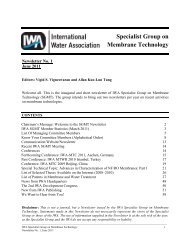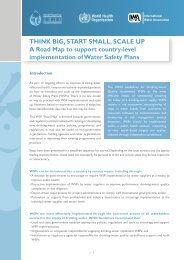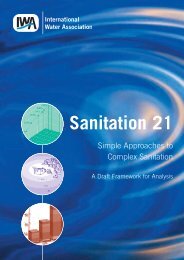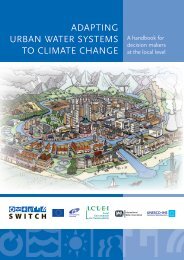Specialist Group on Microbial Ecology and Water Engineering - IWA
Specialist Group on Microbial Ecology and Water Engineering - IWA
Specialist Group on Microbial Ecology and Water Engineering - IWA
Create successful ePaper yourself
Turn your PDF publications into a flip-book with our unique Google optimized e-Paper software.
Meyer, R.L., Saunders, A.M., <strong>and</strong> Blackall, L.L. (2006) Putative glycogen-accumulatingorganisms bel<strong>on</strong>ging to the Alphaproteobacteria identified through rRNA-basedstable isotope probing. Microbiology 152: 419-429.Mino, T., Van Loosdrecht, M.C.M., <strong>and</strong> Heijnen, J.J. (1998) Microbiology <strong>and</strong>biochemistry of the enhanced biological phosphate removal process. <strong>Water</strong>Research 32: 3193-3207.Nittami, T., McIlroy, S., Seviour, E.M., Schroeder, S., <strong>and</strong> Seviour, R.J. (2009)C<strong>and</strong>idatus M<strong>on</strong>ilibacter spp., comm<strong>on</strong> bulking filaments in activated sludge, aremembers of Cluster III Defluviicoccus. Systematic <strong>and</strong> Applied Microbiology 32:480-489.Seviour, R.J., <strong>and</strong> McIlroy, S. (2008) The microbiology of phosphorus removal inactivated sludge processes- the current state of play. The Journal of Microbiology46: 115-124.W<strong>on</strong>g, M.-T., <strong>and</strong> Liu, W.-T. (2007) Ecophysiology of Defluviicoccus-related tetradformingorganisms in an anaerobic-aerobic activated sludge process. Envir<strong>on</strong>mentalMicrobiology 9: 1485-1496.W<strong>on</strong>g, M.-T., Tan, F.M., Ng, W.J., <strong>and</strong> Liu, W.-T. (2004) Identificati<strong>on</strong> <strong>and</strong> occurrenceof tetrad-forming Alphaproteobacteria in anaerobic-aerobic activated sludgeprocesses. Microbiology 150: 3741-3748.BIOCONTROL OF FOAMING MYCOLATA IN ACTIVATED SLUDGEWASTEWATER TREATMENT PLANTS USING BACTERIOPHAGES.Zoe Dys<strong>on</strong> & Steve PetrovskiBiotechnology Research CentreLa Trobe University, Bendigo, 3550, AustraliaFoaming is a major problem in activated sludge wastewater treatment plants worldwide.It leads to increases in maintenance costs, safety issues <strong>and</strong> poor quality effluent.Foaming is typically caused by the proliferati<strong>on</strong> of filamentous hydrophobic bacteriaincluding C<strong>and</strong>idatus ‘Microthrix parvicella’ <strong>and</strong> those that produce mycolic acids intheir cell walls (the Mycolata). These include members of the genera Corynebacterium,Gord<strong>on</strong>ia, Tsukamurella, Dietzia, Mycobacterium, Nocardia, Rhodococcus, Millisia <strong>and</strong>Skermania. Although many c<strong>on</strong>trol strategies have been proposed, (Soddell 1999), nomethod is available to deal with all activated sludge foams. This certainly reflects ourlack of underst<strong>and</strong>ing of the microbial ecology of foams, <strong>and</strong> true extent of thebiodiversity of foaming bacteria. Finding suitable methods to identify precisely suchpopulati<strong>on</strong>s has been a l<strong>on</strong>g st<strong>and</strong>ing problem, <strong>and</strong> although FISH probes are nowavailable for some of these, many still can not be identified this way.Earlier work carried out here by Julie Thomas (Thomas et al., 2002) dem<strong>on</strong>strated thefrequent presence in activated sludge of bacteriophages infective for many of the foamingMycolata. Recently, we have extended this work by isolating from Australian_________________________________________________________________________________________________<strong>IWA</strong> <str<strong>on</strong>g>Specialist</str<strong>on</strong>g> <str<strong>on</strong>g>Group</str<strong>on</strong>g> <strong>on</strong>: <strong>Microbial</strong> <strong>Ecology</strong> <strong>and</strong> <strong>Water</strong> <strong>Engineering</strong> 14Newsletter December 2009


